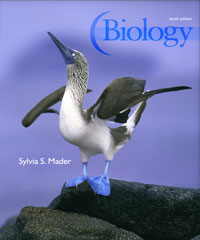Biology (Mader), 10th EditionChapter 34:
Digestive Systems and NutritionLearning OutcomesAfter studying this chapter, you should be able to accomplish the following outcomes.
Digestive Tracts - Compare the digestive tracts of animals in terms of incomplete versus complete tracts, continuous versus discontinuous feeders, and adaptations to diet.
Human Digestive Tract- Describe the anatomy of the human mouth, and contrast mechanical and chemical digestion in the mouth.
- Describe the anatomy of the pharynx and changes that occur during swallowing.
- Describe the anatomy of the esophagus and the process of peristalsis.
- Describe the anatomy of the stomach and the function of gastric glands.
- Describe the anatomy of the small intestine and its role in chemical digestion and absorption of nutrients.
- Describe the structure and function of the large intestine and common illnesses associated with the large intestine.
- Describe several functions of the pancreas and liver and two serious liver disorders.
Digestive Enzymes
- Outline the usual steps for the digestion of starch and lipids, and tell how the products of digestion are absorbed.
Nutrition- Compare the benefits and drawbacks of carbohydrates, lipids, and proteins in the diet.
- Discuss how to control diabetes type 2 and cardiovascular disease through diet and exercise.
- In general, discuss the need for minerals and vitamins in the diet.
- Explain how to interpret a nutrition label.
- Define three types of eating disorders, and list the harmful consequences of each.
 | 




